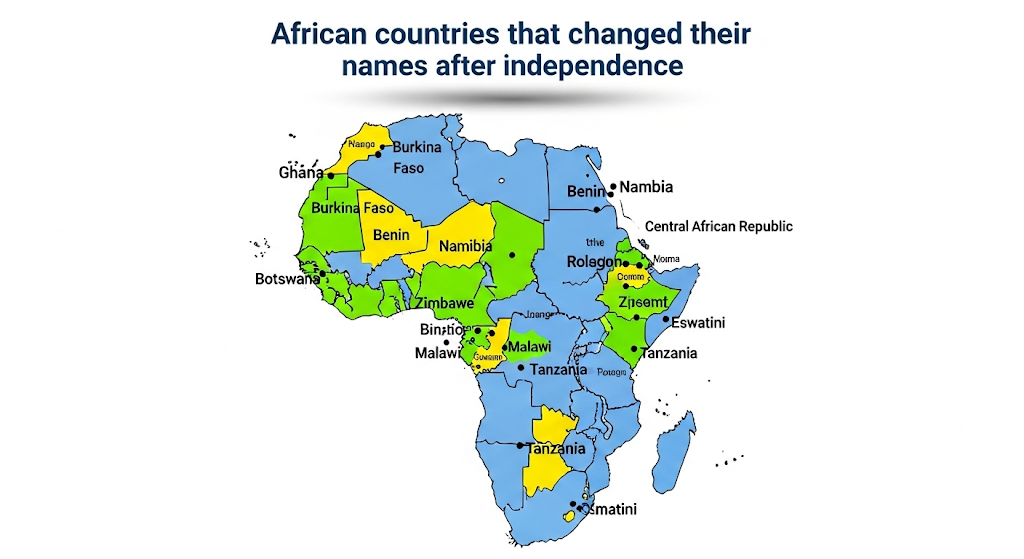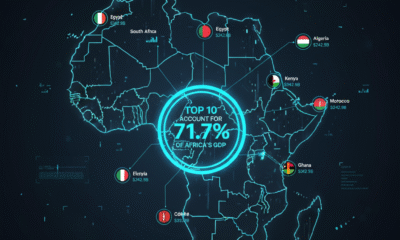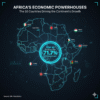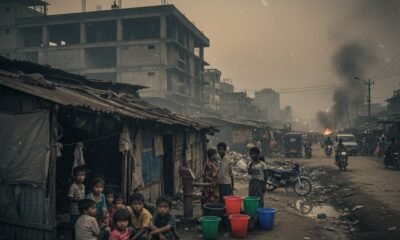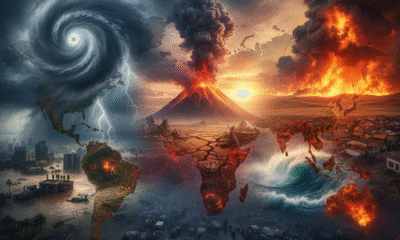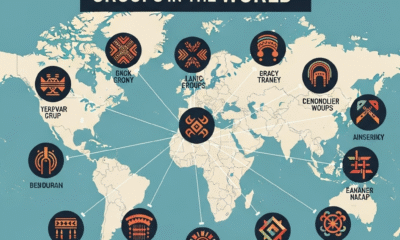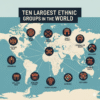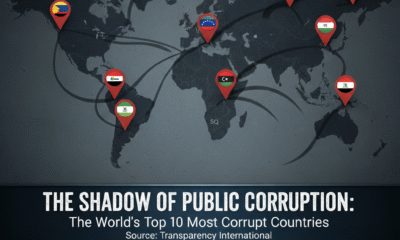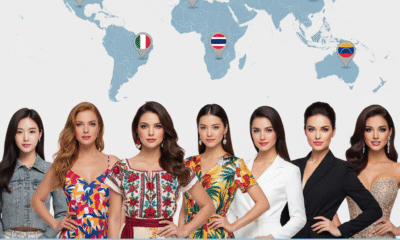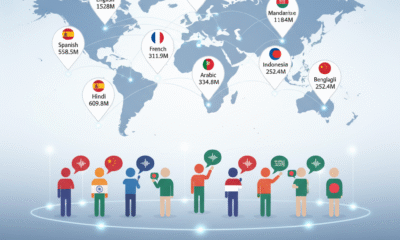News
African Countries That Changed Their Names After Independence
For many countries in Africa, a name change is a key part of gaining a new identity and a way to reclaim their story and honor their heritage after gaining their independence.
These name changes hold special importance in Africa. During the colonial era, European powers gave many African territories new names. The names often reflected colonial interests or a lack of understanding of the land and its people. For example, some names came from rivers, while others honored colonial leaders.
After gaining independence, many African nations made a clear choice to get rid of these colonial names. They replaced them with names that honored their own history, land, and people.
This article looks look at several African countries that changed their names and the reasons behind their choices.
Ghana
Ghana was a British colony known as the Gold Coast. This name, given by European traders, directly referred to the region’s rich gold resources. It highlighted the value of the land for colonial profit, not its people or culture. The name was a clear symbol of the country’s colonial exploitation and history.
The name was officially changed in 1957 when Ghana became the first country in sub-Saharan Africa to gain independence. The new name came from the ancient Ghana Empire, a powerful and wealthy state that existed in West Africa from the 8th to the 13th century.
The change from Gold Coast to Ghana was a very important political and symbolic act. It moved the country away from a name based on resources and towards one based on identity. It became a powerful example for other African nations fighting for their own freedom.
Burkina Faso
Before its name change, this country was known as Upper Volta. French colonial rulers gave it this name. It simply described the country’s location on the upper parts of the Volta River. The name had no connection to the country’s history or its many different ethnic groups. It was a simple geographic label from the perspective of a foreign power.
The name was officially changed in 1984 by President Thomas Sankara. He wanted to break from the colonial past completely. He sought a new name that came from local languages. The new name, Burkina Faso, means “Land of Incorruptible People.” “Burkina” comes from the Mooré language, and “Faso” comes from the Dioula language.
This name change aimed to unite the country under a new shared ideal of integrity and honesty. The new name showed a clear break from colonial rule and a focus on building a strong, unified national character.
Benin
Benin was once known as the Republic of Dahomey. This name came from a powerful ancient kingdom in the southern part of the country. It was very important in the region’s history, but its name did not represent all the different groups of people living in the country which caused some tension after independence.
The country changed its name in 1975. The new name, Benin, was also chosen from a historical kingdom. This kingdom, the Benin Empire, was a large and powerful state. It was not the same as the Kingdom of Dahomey. The new name was meant to be more neutral. It represented a wider, more inclusive history of the region.
The name change was a move to unify the nation and helped to remove old divisions and create a new, shared identity for all citizens.
Democratic Republic of the Congo
This country has had a very complex naming history. As a Belgian colony, it was called the Belgian Congo. After independence in 1960, it became the Republic of the Congo. Then, in 1971, President Mobutu Sese Seko changed the name to Zaire. This was part of a movement to give the country an authentic African identity. Zaire was a local word for “river” and referred to the Congo River.
The change to Zaire was a major political move. It was part of a larger plan to replace all colonial names and traditions. The country’s flag and national anthem were also changed in order to create a new national pride.
The name was changed again in 1997. After President Mobutu was removed from power, the country’s new leaders changed the name back. They chose the name Democratic Republic of the Congo. This change showed a desire to return to the original post-independence name.
Namibia
Before its independence, Namibia was called South West Africa. This name came from its location on the continent. The name was given by the colonial powers. First, it was a German colony. Then, it was controlled by South Africa. The name was a constant reminder of foreign rule. It had no connection to the people or the land itself.
The country gained its independence in 1990. It was the last country in Africa to get its freedom from colonial rule. It chose the name Namibia. The new name came from the Namib Desert. The Namib is a major feature of the country. It is one of the oldest deserts in the world. The new name was a way to honor the land itself and its natural beauty.
Malawi
Malawi was a British colony known as Nyasaland. The name came from Lake Nyasa. This name was given by British explorer David Livingstone in the 1850s. The name was a foreign label. It did not reflect the country’s identity.
The country became independent in 1964. It then changed its name to Malawi. The new name is a local word which comes from the lake. It means “flaming waters.”
Zimbabwe
Zimbabwe was known as Rhodesia. This name was given by the British. It honored Cecil Rhodes, a British businessman who played a big role in colonizing the area.
The name Rhodesia was a direct symbol of colonial rule. It represented a foreign person, not the people of the land.
The name was changed to Zimbabwe in 1980. This happened when the country gained its independence. The name Zimbabwe came from a famous ancient stone city. This city was the center of a great African kingdom.
Botswana
Before its independence, this country was known as Bechuanaland. The name came from the Tswana people who live in the area. The name was given by the British colonial rulers. It was a formal colonial term, not a name chosen by the people themselves.
The country became independent in 1966. It chose the name Botswana. This new name is a simple and direct way of saying “Land of the Tswana.” It directly honors the main ethnic group of the country. The name change was a way to show freedom from colonial rule.
The change was a key part of building a new national identity in the country, it showed that the country’s people were now in charge.
Tanzania
Tanzania’s name change is different from the others. It was formed from two separate countries. One was Tanganyika. The other was Zanzibar. Both of these places had already gained independence. In 1964, the two countries came together to form one nation.
They took parts of each of their old names to create the new one. They took “Tan” from Tanganyika and “Zan” from Zanzibar. They added “ia” at the end to form Tanzania. This name showed that they were now one people.
Eswatini
This country was called Swaziland. The name came from the Swazi people who live there. However, the name was a mix of the local language and English. It was a name given during the colonial period.
The name was officially changed in 2018 by the king of the country, King Mswati III. The new name, Eswatini, means “Land of the Swazis” in the local language. The king said the new name was to return to the original name used by the Swazi people. The name change was to celebrate 50 years of independence.
Central African Republic
This country was a French colony and it was called Oubangui-Chari. The name came from two rivers in the area and had no meaning for the people who lived there. It was just a colonial label.
The country gained its independence in 1960 and since then it chose a simple and direct new name of the Central African Republic. The name describes the country’s location in the middle of Africa and it was a way to show its new status as a free nation.

